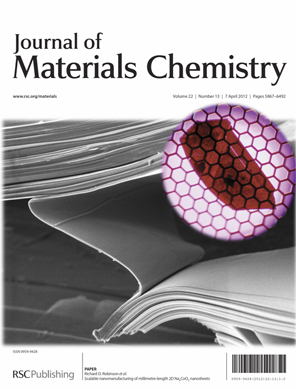Home > Press > Bendable, nontoxic nanosheets could turn waste heat into power
 |
| Robinson group A scanning electron microscope image of the side of a stack of nanosheets. The inset is an optical microscope image of a single exfoliated nanosheet, to show it is optically transparent. |
Abstract:
Cornell materials scientists have developed an inexpensive, environmentally friendly way of synthesizing oxide crystal sheets, just nanometers thick, which have useful properties for electronics and alternative energy applications.
Bendable, nontoxic nanosheets could turn waste heat into power
Ithaca, NY | Posted on April 10th, 2012The work, led by Richard Robinson, assistant professor of materials science and engineering, is featured on the cover of the April 7 Journal of Materials Chemistry (Vol. 22, No. 13).
The millimeter-length, 20 nanometer-thick sodium-cobalt oxide crystals were derived through a novel method that combined a traditional sol-gel synthesis with an electric field-induced kinetic de-mixing step. It was this second step that led to the breakthrough of a bottom-up synthesis method through which tens of thousands of nanosheets self-assemble into a pellet.
The material has fascinating properties, Robinson said, including high thermoelectric power, high electrical conductivity, superconductivity and potential as a cathode material in sodium ion batteries.
Usually oxide materials, like a ceramic coffee mug, aren't electrically conductive; they're insulating, Robinson said. Since the material is a conductive oxide, it can be used in thermoelectric devices to convert waste heat into power. Now that the researchers have made nanosheets, they expect the material's thermoelectric efficiency to improve, enabling the creation of more efficient alternative energy thermoelectric devices.
The nanosheets also show the ability to bend, sometimes up to 180 degrees, Robinson added. This is unusual for ceramics, which are normally brittle.
The material is based on common, abundant elements (sodium, cobalt and oxygen), without toxic elements, such as tellurium, that are normally used in thermoelectric devices.
The paper's co-authors are graduate students Mahmut Aksit and David Toledo. The work was supported by the National Science Foundation and the U.S. Department of Energy, through the Energy Materials Center at Cornell (EMC2).
####
For more information, please click here
Contacts:
Anne Ju
(607) 255-9735
Chronicle Online
312 College Ave.
Ithaca, NY 14850
607.255.4206
Copyright © Cornell University
If you have a comment, please Contact us.Issuers of news releases, not 7th Wave, Inc. or Nanotechnology Now, are solely responsible for the accuracy of the content.
| Related News Press |
News and information
![]() Researchers develop molecular qubits that communicate at telecom frequencies October 3rd, 2025
Researchers develop molecular qubits that communicate at telecom frequencies October 3rd, 2025
![]() Next-generation quantum communication October 3rd, 2025
Next-generation quantum communication October 3rd, 2025
![]() "Nanoreactor" cage uses visible light for catalytic and ultra-selective cross-cycloadditions October 3rd, 2025
"Nanoreactor" cage uses visible light for catalytic and ultra-selective cross-cycloadditions October 3rd, 2025
Chip Technology
![]() Lab to industry: InSe wafer-scale breakthrough for future electronics August 8th, 2025
Lab to industry: InSe wafer-scale breakthrough for future electronics August 8th, 2025
![]() A 1960s idea inspires NBI researchers to study hitherto inaccessible quantum states June 6th, 2025
A 1960s idea inspires NBI researchers to study hitherto inaccessible quantum states June 6th, 2025
![]() Programmable electron-induced color router array May 14th, 2025
Programmable electron-induced color router array May 14th, 2025
Discoveries
![]() Researchers develop molecular qubits that communicate at telecom frequencies October 3rd, 2025
Researchers develop molecular qubits that communicate at telecom frequencies October 3rd, 2025
![]() Next-generation quantum communication October 3rd, 2025
Next-generation quantum communication October 3rd, 2025
![]() "Nanoreactor" cage uses visible light for catalytic and ultra-selective cross-cycloadditions October 3rd, 2025
"Nanoreactor" cage uses visible light for catalytic and ultra-selective cross-cycloadditions October 3rd, 2025
Materials/Metamaterials/Magnetoresistance
![]() First real-time observation of two-dimensional melting process: Researchers at Mainz University unveil new insights into magnetic vortex structures August 8th, 2025
First real-time observation of two-dimensional melting process: Researchers at Mainz University unveil new insights into magnetic vortex structures August 8th, 2025
![]() Researchers unveil a groundbreaking clay-based solution to capture carbon dioxide and combat climate change June 6th, 2025
Researchers unveil a groundbreaking clay-based solution to capture carbon dioxide and combat climate change June 6th, 2025
![]() A 1960s idea inspires NBI researchers to study hitherto inaccessible quantum states June 6th, 2025
A 1960s idea inspires NBI researchers to study hitherto inaccessible quantum states June 6th, 2025
![]() Institute for Nanoscience hosts annual proposal planning meeting May 16th, 2025
Institute for Nanoscience hosts annual proposal planning meeting May 16th, 2025
Announcements
![]() Rice membrane extracts lithium from brines with greater speed, less waste October 3rd, 2025
Rice membrane extracts lithium from brines with greater speed, less waste October 3rd, 2025
![]() Researchers develop molecular qubits that communicate at telecom frequencies October 3rd, 2025
Researchers develop molecular qubits that communicate at telecom frequencies October 3rd, 2025
![]() Next-generation quantum communication October 3rd, 2025
Next-generation quantum communication October 3rd, 2025
![]() "Nanoreactor" cage uses visible light for catalytic and ultra-selective cross-cycloadditions October 3rd, 2025
"Nanoreactor" cage uses visible light for catalytic and ultra-selective cross-cycloadditions October 3rd, 2025
Energy
![]() Sensors innovations for smart lithium-based batteries: advancements, opportunities, and potential challenges August 8th, 2025
Sensors innovations for smart lithium-based batteries: advancements, opportunities, and potential challenges August 8th, 2025
![]() Simple algorithm paired with standard imaging tool could predict failure in lithium metal batteries August 8th, 2025
Simple algorithm paired with standard imaging tool could predict failure in lithium metal batteries August 8th, 2025
|
|
||
|
|
||
| The latest news from around the world, FREE | ||
|
|
||
|
|
||
| Premium Products | ||
|
|
||
|
Only the news you want to read!
Learn More |
||
|
|
||
|
Full-service, expert consulting
Learn More |
||
|
|
||








